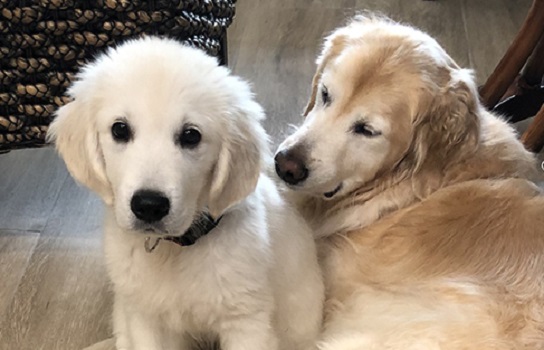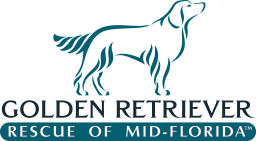From Pups to Seniors

Who doesn’t love a cute, bouncy, fluffy, bundle of fur! But how long will your bundle of fur stay a puppy? Comparing human age to dog years isn’t as easy as the seven-year rule. According to the 2019 AAHA Canine Life Stage Guidelines, there are four main stages in a dog’s life: puppy, young adult, mature adult and senior.
Puppy which begins at birth and continues until the end of rapid growth, generally lasts between 6-9 months depending on the breed of the dog. Puppies have a sensitive period for socialization which runs roughly between three weeks and three months. This is a crucial learning period; puppies that aren’t properly socialized during this period may be fearful towards new people, other dogs or animals, sounds, objects or their environment.
Below are some things to consider for safety, nutrition, socialization and training:
- Purchase books and videos by professional (positive reinforcement) trainers and behaviorist.
- Consult your veterinarian about vaccinations, microchip identification, heart worm, flea tick prevention, spay/neuter time frames, supplements, nutrition, exercise for your breed and breed awareness.
- Puppy proof your home- keep electrical cords safely away from chewing, toxic materials should be stored in a safe place (including medications and plants). Think of your puppy as an infant that can crawl – put everything they shouldn’t touch out of reach.
- Provide your puppy with appropriate chew items, toys and games.
- Supervise your puppy at all times or make sure they are in a safe pen or crate area (no free roaming without supervision).
- Safety: Crate training, on leash, fenced yards, transportation safety (restraint, temperature in cars, no riding in open truck or with windows wide open).
- Find a certified dog trainer (CPDT, CPDT-KA) who is knowledgeable about dog behavior and teaches positive reinforcement learning.
- Consult your veterinarian for approval and get your puppy started in a puppy class at 7-8 weeks. The American Veterinary Society of Animal Behavior states, “In general, puppies can start puppy socialization classes as early as 7-8 weeks of age. Puppies should receive a minimum of one set of vaccines at least 7 days prior to the first class and a first deworming. They should be kept up-to-date on vaccines throughout the class.”
- Teach your puppy bite inhibition (puppy learn to restrain the force of his bite “soft mouth”) before 18 weeks old. This is something that your puppy class will help with if they have supervised play time with other puppies.
- If you have a well-mannered older dog, they may help you in teaching your puppy or young dog proper etiquette. Puppies will often follow and mimic older dogs behaviors.
- Enjoy, love and be kind to your puppy at all times.
Young Adult starts when the puppy stage ends, and young dogs go through a period where they are still maturing both socially and physically. This stage usually lasts to about 3-4 years of age. Think of your golden as you would a teenager, you may struggle with your dog’s behavior or training at this time.
Below are some suggestions for your young dog’s social and physical well-being;
- Continue with training by signing up for an adult dog obedience class.
- If your dog has behavioral issues (fear of loud noises, aggression, separation anxiety, food guarding, excessive barking, etc.) be pro-active in seeking professional advice from your veterinarian or a professional trainer who is certified as a dog behavior consultant (CDBC). Don’t assume your dog will grow out of it, often the behavior will get worse.
- Consider finding a hobby for your dog that you and they can both enjoy: agility, nose work (link), therapy dog visits, Flyball, Dock Diving (see GRRMF Newsletter,dated Aug. 2019 for more information). Remember that a dog’s physical abilities and temperament should be considered when choosing an activity they will enjoy. Some dogs may not enjoy being petted or made over by lots of new people in a structured setting, but they would be outstanding in nose work or dock diving.
- Dogs burn energy three ways; with their paws, brain and mouth. Don’t forget that small breeds need physical and cognitive enrichment as much as larger breeds.
Mature Adult stage continues for the next quarter of their expected lifespan. At this time, you and your dog have a routine and they are well trained and happy. Don’t get complacent with your training though, continue to reward the positive behaviors.
Below are some suggestions and signs you should look for as your dog matures:
- Continue to keep your dog active in physical and mentally stimulating activities that are suitable for their age.
- Make sure they are still getting social interaction with people, animals and new environments.
- Behavior changes can be due to medical problems and not out of spite. If a potty-trained dog starts urinating in the house, it may be a sign that there is an underlying medical problem that should be examined by a veterinarian.
- Watch for other changes such as reactivity, new fears, stress from being left alone, becoming less active, aggression, licking/grooming excessively these could be signs of physical or cognitive problems. Consult your veterinarian as soon as possible if you have concerns.
Seniors are in the last quarter of their life. It’s important to keep your dog active and social with your family and friends. This is a time that you may need to alter things in your home so that your dog can easily get around and be supported properly. Non-skid rugs or mats, harnesses, doggie boots, ramps, and orthopedic beds may be needed at this time. Senior dogs can still enjoy walks, car rides and fun activities; being with you is their greatest desire. Moderate activity, nutrition and frequent health examinations are key to keeping your best friend happy, healthy and enriched in their golden years.
Below are some geriatric symptoms to be aware of:
- Weakness, lethargy
- Coughing, difficulty breathing.
- Increased thirst/increased urination
- Still or sore after exercising
- Seizures
- Eating habits have changed
- Sudden weight loss or gain
- Bad breath or red and irritated gums
- Poor hair coat or skin conditions
- Impairments to vision and hearing
- Mobility changes
- Cognitive dysfunction -disorientation, reduced social interaction, increased anxiety and fear, sleeping more during the day, pacing/wandering, restlessness at night and house soiling can all be signs of Canine Cognitive Dysfunction (CCD), your veterinarian will want to do a evaluation to rule out other diseases that may have similar signs before making this diagnosis.
Regardless of your dog’s age, the love and joy they bring far outweigh any special needs. Good health care, nutrition, exercise, and a loving family will keep your dog happy and healthy in every stage of life.
References:
- Creevy K,Grady J,Little,S DVM, et al. (2019) AAHA Canine Life Stage Guidelines, Journal of the American Animal Hospital Association, 55: 267-290, aaha.org
- Todd Z, Ph.D,Cert.Trainer, (2019) Psychology Today, The Life Stages of Dogs:From Puppies to Seniors.
- American Veterinary Society of Animal Behavior (2008) AVSAB position statement on puppy socialization,avsab.org
- Yin,S DVM.MS (2011) Perfect Puppy in 7 Days: How to Start Your Puppy Off Right drsophiayin.com
- Dunbar,I DVM (1st Pub.2001) After You Get Your Puppy, dog star daily
- Miller, P, CBCC-KA,CPDT-KA (2004,2019) Young Dogs Learn From Older Well-Behaved Dogs “Whole Dog Journal”, whole-dog-journal.com
- Kidd,R DVM,PhD (2005,2019) The Canine Aging Process “Whole Dog Journal.”
Other Readings:
- Donaldson,J (1998,2010) Dogs Are From Neptune 2nd Edition, dogwisepublishing.com
- Donaldson, J (2013) The Culture Clash, dogwisepublishing.com
- Editorial Staff (2001,2019) So You’ve Decided to Adopt an Older Dog, “Whole Dog Journal”,whole-dog-journal.com
